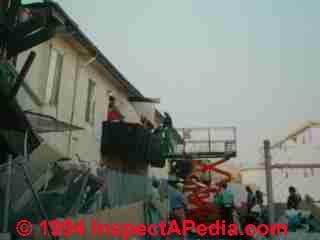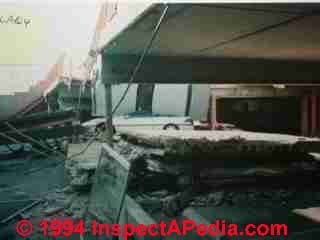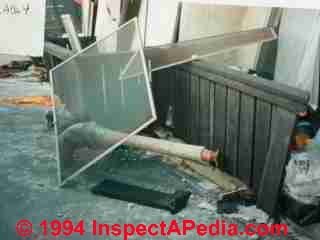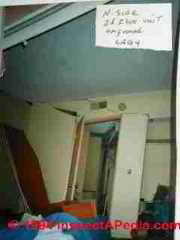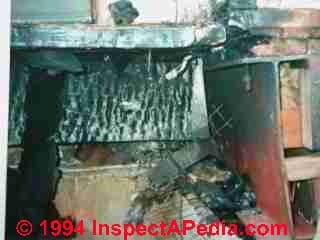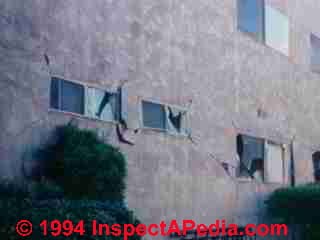 Earthquake damage photographs
Earthquake damage photographs
Damage from earthquakes, 1994 Northridge CA
- POST a QUESTION or COMMENT about photographs of various types of earthquake damage to buildings
Photographs of types of earthquake damage:
This article series describes earthquake damage graphically, beginning with an extensive collection of photographs of earthquake damage from the Northridge California earthquake of 1994.
We include expert source citations and references to additional articles on specific areas of earthquake damage to structures such as chimneys, foundations, mechanical systems, and to earthquake-damage control construction details typical for residential and light commercial structures.
InspectAPedia tolerates no conflicts of interest. We have no relationship with advertisers, products, or services discussed at this website.
- Daniel Friedman, Publisher/Editor/Author - See WHO ARE WE?
Earthquake Damage Photographic Library
The following photographs, taken by the author [DF] were taken in and around Los Angeles immediately after the 1994 Northridge Earthquake in California.
Occurring in January 1994 this earthquake killed at least 24 people and collapsed numerous buildings as well as sections of the California freeway.
[Click to enlarge any image]
The New York Times edition for 17 January 1994 (left) reported that the pre-dawn tremor leveled many buildings, left others askew and unsafe, and injured hundreds.
At the end of March 2014, 20 years after we worked at the Northridge Meadows earthquake scene, The New York Times provided an update to the California earthquake hazard, reporting on quakes occurring on 3/28/2014 that included a long, rolling 5.1 quake, the first in excess of five since 1887.
The Times article cited three current (2014) principal earthquake preparedness concerns for California: the need to reinforce buildings that are in danger of collapse in a new major earthquake, and the necessity for planning to handle "catastrophic collapses in water supply and basic communication". - The New York Times, 3/31/2014.
In the 1994 Los Angeles earthquake dozens of fires also occurred as ruptured gas lines and gas leaks were ignited. Sorting through earthquake-damaged areas classified as red (destroyed), yellow (major damage), and green (safe to occupy) requires trained damage assessment teams who can make rapid but reliable damage assessment.
Along with other agencies the American Red Cross needs this information to guide how and what assistance is provided in earthquake zones and in setting priorities of attention.
 Following the Northridge earthquake in 1994, LA authorities were receiving 300 calls/hr for building inspectors to tell people whether or not they could reenter their homes. Two of us present at a San Diego home inspection conference organized inspectors to assist the ARC in helping to provide that service.
Following the Northridge earthquake in 1994, LA authorities were receiving 300 calls/hr for building inspectors to tell people whether or not they could reenter their homes. Two of us present at a San Diego home inspection conference organized inspectors to assist the ARC in helping to provide that service.
Working as a volunteer to provide emergency damage assessment assistance for the American Red Cross, a handful of members of ASHI, the American Society of Home Inspectors, and including the author, spent several weeks investigating both areas of major damage, including the sites of fatalities, and other areas where damage was minimal or even non-existent.
Photo at left: section of LA freeway that collapsed during the 1994 Northridge quake. L. a. drivers may have pretended to be cool following this earthquake, but I noticed that when traffic lights turned red, nobody wanted to sit with their car idling beneath sections of freeway that remained standing.
Drivers would jockey to stop before the freeway underpass or to just push on through it in response to red lights.
This earthquake was particularly damaging in part because the movement it produced included a side-to-side lurching as well as vertical displacement.
While engineering and architecture experts in seismic construction and earthquake damage have studied with care the damage caused by this and other earthquakes, both natural and manmade, some causes of damage were evident even to more humble home inspectors familiar with construction snafus.
Working as a damage assessment volunteer requires different thinking than typical building damage assessment performed by home inspectors and code compliance officers. The first question is "is the building still there?". Second, is the building standing and conceivably repairable.
Even minor amounts of movement in a structure can render it not habitable if it has no safe working mechanical systems; the municipality does not want squatters in unsanitary or unsafe buildings.
On arriving in Los Angeles we found that many people were very frightened - although we were charged with looking only at the outside of buildings, because I speak spanish we were asked into several buildings which were occupied by people afraid to stay therein - despite previous information from non-spanish speakers that it was ok.
The language helped. Preliminary damage assessment had already been done in those areas, meaning that someone had already established whether there was any serious damage. However LA is so big that there remained very large areas that have not been examined even for PDA.
More details of the Northridge Meadows complex collapse and damage are shown in the next six photographs.
Two of us, D. Friedman and Ken Young, were also sent off to double-check for earthquake damage in Watts, an area still suffering from burnout and only limited re-building after the Watts riots that occurred August 11-17, 1965.
Driving up and down every street to screen for damage in the district required permission from and checking for damage reports from and with both local police and ... some other people in neighborhoods still not warmly welcoming outsiders creeping around their streets.
At below left is a closer view of the shear point between the Northridge Meadows floor sections that collapsed and those that remained standing.
Ken and I also visited Sherman Oaks, one of the more severely-damaged earthquake districts.
It was obvious even to novice earthquake damage inspectors that in addition to the luck of the draw common to such disasters, construction practices made a very big difference - not in actually avoiding building damage but in avoiding building collapse.
Structures that held together permitted occupants to escape. Other buildings collapsed, crushing entire floors from which escape was not much short of miraculous.
Un reinforced masonry chimneys collapsed both into and outside of homes.
At homes whose exterior masonry walls were un reinforced (above right and below left - Granada Hills area) entire wall sections collapsed. Buildings with seismic reinforcement fared better - avoiding catastrophic collapse and thus injuring far fewer people (below right) even though damage was in some cases so extreme that demolition rather than repair was anticipated.
In our OPINION, un reinforced masonry chimneys that coursed through the interior of buildings were particularly hazardous to occupants, as collapsing masonry could easily fall through a ceiling and into a bedroom where occupants were sleeping at the time of the quake (below left).
Chimneys were left teetering on some homes, making occupancy unsafe.
Lateral Shift of Buildings off of Foundation & Subsequent Vertical Collapse during Earthquake
Below: lateral movement shifted homes off of foundations; movement such as that at below left was immediately apparent, but other homes suffered more subtle damage that left the home "apparently" still secure on its foundation until a closer inspection disclosed broken connections or more immediate hazards such as unsafe gas lines (below right) or electrical wiring, and unsanitary conditions such as broken sewer connections in crawl spaces.
x
Northridge Meadows Collapse: January 1994 Earthquake Fatalities & Survivors
At above left workers were removing salvageable bedding from Northridge Meadows - the apartment complex that suffered particular damage and a number of fatalities (below).
Some survivors, by miraculous luck, were tossed into spaces that were not crushed as some upper portions of the building fell and crushed the first floor spaces (above right).
As the photographs above explain, other occupants at Northridge Meadows were far less fortunate.
At below left, sections of the parking area supported by Lally columns and below collapsed sections of Northridge Meadows apartments were crushed by the building above.
In my OPINION no building code compliance inspector can possibly check every single connection and detail on a large project - nor are those experts expected to do so. Instead code enforcement officials must rely on a combination of spot inspections, documentation, and the work of the architects, engineers, and builders supervising the project.
Earthquake induced collapse of crawl space cripple walls
Even a small lateral or vertical displacement in building movement can leave electrical, gas, or plumbing systems out of order or unsafe (below left). Larger horizontal displacements are obvious (below right) and on homes built over crawlspaces that lacked seismic connectors were very often combined with a vertical drop as the crawl area collapsed. Notice the differences in height between the masonry stairway landing and the bottom of the storm door in our photo at below right.
These details afford very rapid earthquake damage assessment information.
More examples of the effects of extreme lateral movement followed by a vertical drop in the building structure are shown below.
Rapid earthquake damage assessment is also facilitated by simple observations of collapsing floors such as in the photograph at below left.
As much as two weeks after the earthquake, and not surprising, in more remote neighborhoods we found people still living in severely damaged homes that had shifted off of their foundation (below right) and on occasion still without having availed themselves of emergency relief.
At below left I'm at a severely damaged home outside of Los Angeles and well outside of the primary inspection and assistance zone.
Retaining walls often provided the first obvious and unambiguous indication of the direction of lateral displacement when entering a neighborhood (below right).
Some crawl space knee walls or cripple walls bent but did not collapse completely (below left). Those that did typically levered the building over to one side by an amount equal to the height of the cripple walls (below right).
x
The home whose damage is shown below collapsed straight down when its cripple walls buckled.
Northridge Earthquake parking lot collapse photos - concrete reinforcement questions
Some collapses such as the elevated parking area (above left) may have been due to improper concrete reinforcement installation during initial construction. Such construction details remain hidden from view inside of solid concrete until a catastrophe breaks building materials apart to shed light on original construction details.
At below left I'm pointing to ... well it's hard to point to an absence, but we didn't see evidence that the steel reinforcing mesh had been overlapped nor tied together at the point of break-away parking lot sections shown in the photographs above.
At below right, back at Northridge Meadows, upper floors of building sections lie on the ground as we began a tour of steel column details.
Steel Lally Column Failures & Bending at the Northridge Earthquake in 1994
Construction details such as where exterior sheathing was not staggered between building wall sections (above right), substitution of hollow pipes for concrete-filled steel Lally columns (above right and below) and of course on on many older homes, construction without earthquake-resistant structural fasteners and using un reinforced masonry led to many collapses.
At above right, what had been the second floor level of Northridge Meadows was now on the ground.
Where I could see into some of these bent columns, they were hollow. Once a Lally column is wrapped with fire-resistant materials these were, how would an inspector know if the column were a simple hollow steel pipe or a concrete filled Lally?
Also see COLUMN / POST RUST DAMAGE
Fires from ruptured gas lines following the Northridge Earthquake in 1994
Moments after taking this earthquake-related fire damage photograph from beneath a partly-collapsed overhanging structure an after-shock brought this building to the ground.
Exterior Wall Crack Patterns at Windows & Doors after Earthquake Damage
Photo-comparison of earth quake resistant high rise with single family wood frame construction after Northridge
The under-floor heater pushed up the heating register and plenum when the floor fell around it (below left).
In comparison, in downtown L. A. high rise buildings such as shown in my photo at below right swayed and made terrifying creaking noises
- I could hear debris falling inside of the wall cavities in upper floors during aftershocks - but the buildings remained essentially un-damaged and safe for their occupants - despite at least one who, unfamiliar with earthquake aftershocks, considered leaping from the upper floor of a high-rise during a nighttime aftershock but was rescued by Mary Fisher.
CONTACT US if you are a professional requiring higher resolution or background details. Additional photographs of other earthquake locations and damage are being added to this series. Contributions are requested to expand this resource, without charge, for scholarly or professional purposes.
...
Continue reading at EARTHQUAKE DAMAGE PHOTOS CHRISTCHURCH 2010-2011 or select a topic from the closely-related articles below, or see the complete ARTICLE INDEX.
Or see these
Recommended Articles
Suggested citation for this web page
EARTHQUAKE DAMAGE PHOTOS CA 1994 at InspectApedia.com - online encyclopedia of building & environmental inspection, testing, diagnosis, repair, & problem prevention advice.
Or see this
INDEX to RELATED ARTICLES: ARTICLE INDEX to BUILDING DAMAGE, DISASTER, REPAIRS
Or use the SEARCH BOX found below to Ask a Question or Search InspectApedia
Or see
INDEX to RELATED ARTICLES: ARTICLE INDEX to BUILDING STRUCTURES
Or use the SEARCH BOX found below to Ask a Question or Search InspectApedia
Ask a Question or Search InspectApedia
Try the search box just below, or if you prefer, post a question or comment in the Comments box below and we will respond promptly.
Search the InspectApedia website
Note: appearance of your Comment below may be delayed: if your comment contains an image, photograph, web link, or text that looks to the software as if it might be a web link, your posting will appear after it has been approved by a moderator. Apologies for the delay.
Only one image can be added per comment but you can post as many comments, and therefore images, as you like.
You will not receive a notification when a response to your question has been posted.
Please bookmark this page to make it easy for you to check back for our response.
IF above you see "Comment Form is loading comments..." then COMMENT BOX - countable.ca / bawkbox.com IS NOT WORKING.
In any case you are welcome to send an email directly to us at InspectApedia.com at editor@inspectApedia.com
We'll reply to you directly. Please help us help you by noting, in your email, the URL of the InspectApedia page where you wanted to comment.
Citations & References
In addition to any citations in the article above, a full list is available on request.
- Adam Nagourney, "For Californians, 2 Earthquakes Have Put Put Preparedness Back on the Map", The New York Times, p. A11, 3/31/2014
- [1] Arakida, Masaru. "Measuring vulnerability: The ADRC perspective for the theoretical basis and principles of indicator development." Measuring Vulnerability to Natural Hazards–towards disaster resilient societies, United Nations University Press, Tokyo (2006): 290-299.
- [2] Comerio, Mary C. "Public policy for reducing earthquake risks: a US perspective." Building Research & Information 32, no. 5 (2004): 403-413.
- [3] Kamat, Vineet R., and Sherif El-Tawil. "Evaluation of augmented reality for rapid assessment of earthquake-induced building damage." Journal of computing in civil engineering 21, no. 5 (2007): 303-310.
- [4] Kovacs, Paul. Reducing the risk of earthquake damage in Canada: Lessons from Haiti and Chile. Institute for Catastrophic Loss Reduction, 2010.
- [5] Mills, Evan, Evan Mills, and Ivo Knoepfel. Energy-efficiency options for insurance loss prevention. Environmental Energy Technologies Division, Ernest Orlando Lawrence Berkeley National Laboratory, 1997.
- [6] Noji, Eric K., and Keith T. Sivertson. "Injury prevention in natural disasters. A theoretical framework." Disasters 11, no. 4 (1987): 290-296.
- [7] Peek-Asa, Coritme, Jess F. Kraus, Linda B. Bourque, Dushyanthi Vimalachandra, Jenny Yu, and Jackie Abrams. "Fatal and hospitalized injuries resulting from the 1994 Northridge earthquake." International Journal of Epidemiology 27, no. 3 (1998): 459-465.
- [8] John Tagliabue, Parts of Low Country Are Now Quake Country", The New York Times, 27 March 2013, p. A6.
- [9] "A Foundation for Unstable Soils," Harris Hyman, P.E., Journal of Light Construction, May 1995
- [10] "Backfilling Basics," Buck Bartley, Journal of Light Construction, October 1994
- [11] "Inspecting Block Foundations," Donald V. Cohen, P.E., ASHI Reporter, December 1998. This article in turn cites the Fine Homebuilding article noted below.
- [12] Henry Fountain, "Experts Eye Oil and Gas Industry as Quakes Shake Oklahoma", The New York Times, 13 December 2013, p. A20, A23.
- [13] Stein, Ross S. "The role of stress transfer in earthquake occurrence." Nature 402, no. 6762 (1999): 605-609. US Geological Survey, MS 977, Menlo Park, California 94025, USA , Email: rstein@usgs.gov.
- [14] Lin, Jian, and Ross S. Stein. "Stress triggering in thrust and subduction earthquakes and stress interaction between the southern San Andreas and nearby thrust and strike‐slip faults." Journal of Geophysical Research: Solid Earth (1978–2012) 109, no. B2 (2004).
- [15] Parsons, Tom, Ross S. Stein, Robert W. Simpson, and Paul A. Reasenberg. "Stress sensitivity of fault seismicity: A comparison between limited‐offset oblique and major strike‐slip faults." Journal of Geophysical Research: Solid Earth (1978–2012) 104, no. B9 (1999): 20183-20202.
- [16] Toda, Shinji, Jian Lin, Mustapha Meghraoui, and Ross S. Stein. "12 May 2008 M= 7.9 Wenchuan, China, earthquake calculated to increase failure stress and seismicity rate on three major fault systems." Geophysical Research Letters 35, no. 17 (2008).
- [17] Parsons, Tom, and Douglas S. Dreger. "Static‐stress impact of the 1992 Landers earthquake sequence on nucleation and slip at the site of the 1999 M= 7.1 Hector Mine earthquake, southern California." Geophysical research letters 27, no. 13 (2000): 1949-1952.
- [18] King, G. C. P., and M. Cocco. "Fault interaction by elastic stress changes: New clues from earthquake sequences." Advances in Geophysics 44 (2001): 1-VIII.
- [19] Toda, Shinji, and Ross Stein. "Toggling of seismicity by the 1997 Kagoshima earthquake couplet: A demonstration of time-dependent stress transfer." Journal of geophysical research 108, no. B12 (2003): 2567.
- [20] Simpson, Robert W., and Paul A. Reasenberg. "Earthquake-induced static stress changes on central California faults." US Geol. Surv. Prof. Pap 55 (1994): 89.
- [21] Cocco, Massimo, Concetta Nostro, and G. Ekström. "Static stress changes and fault interaction during the 1997 Umbria-Marche earthquake sequence." Journal of seismology 4, no. 4 (2000): 501-516.
- [22] Zeng, Yuehua. "Viscoelastic stress‐triggering of the 1999 Hector Mine Earthquake by the 1992 Landers Earthquake." Geophysical research letters 28, no. 15 (2001): 3007-3010.
- [23] Toda, Shinji, Jian Lin, and Ross S. Stein. "Using the 2011 M= 9.0 Tohoku earthquake to test the Coulomb stress triggering hypothesis and to calculate faults brought closer to failure." Earth Planets Space 63 (2011): 1-6.
- [24] Freed, Andrew M. "Earthquake triggering by static, dynamic, and postseismic stress transfer." Annu. Rev. Earth Planet. Sci. 33 (2005): 335-367. Quoting:
Earthquake triggering is the process by which stress changes associated with an earthquake can induce or retard seismic activity in the surrounding region or trigger other earthquakes at great distances. Calculations of static Coulomb stress changes associated with earthquake slip have proven to be a powerful tool in explaining many seismic observations, including aftershock distributions, earthquake sequences, and the quiescence of broad, normally active regions following large earthquakes. Delayed earthquake triggering, which can range from seconds to decades, can be explained by a variety of time-dependent stress transfer mechanisms, such as viscous relaxation, poroelastic rebound, or afterslip, or by reductions in fault friction, such as predicted by rate and state constitutive relations. Rapid remote triggering of earthquakes at great distances (from several fault lengths to 1000s of km) is best explained by the passage of transient (dynamic) seismic waves, which either immediately induce Coulomb-type failure or initiate a secondary mechanism that induces delayed triggering. The passage of seismic waves may also play a significant role in the triggering of near-field earthquakes. - [25] " Man-made earthquake strikes Christchurch ", The New Zealand Herald, 17 April 2012, Quoting: Man-made earthquake strikes Christchurch 3:58 PM Tuesday Apr 17, 2012 A magnitude 4 earthquake is to strike Christchurch - but this one will be man-made. The "earthquake" struck at 11.30am, at QEII Stadium, at a depth of up to 12km. The jolt is part of tests by the Earthquake commission into whether liquefaction-prone land in the east of the city can be repaired. About 25 small underground explosives are to be placed up to 12 metres deep and set off to simulate an earthquake of about magnitude 4.
- [26] William Ellsworth (ellsworth@usgs.gov), Jessica Robertson (jrobertson@usgs.gov), and Christopher Hook (703-648-4460), "Man-Made Earthquakes Update", USGS, 12 July 2013, retrieved 13 December 2013, original source: http://www.usgs.gov/blogs/features/usgs_top_story/man-made-earthquakes/
- [27] Katie M. Keranen, Heather M. Savage, Geoffrey A. Abers and Elizabeth S. Cochran, "Potentially induced earthquakes in Oklahoma, USA: Links between wastewater injection and the 2011 Mw 5.7 earthquake", Geology, January 2013, retrieved 12/13/2013, original source: http://geology.gsapubs.org/content/early/2013/03/26/G34045.1.abstract
Quoting from the abstract:
Significant earthquakes are increasingly occurring within the continental interior of the United States, including five of moment magnitude (Mw) ≥ 5.0 in 2011 alone. Concurrently, the volume of fluid injected into the subsurface related to the production of unconventional resources continues to rise. Here we identify the largest earthquake potentially related to injection, an Mw 5.7 earthquake in November 2011 in Oklahoma. The earthquake was felt in at least 17 states and caused damage in the epicentral region. It occurred in a sequence, with 2 earthquakes of Mw 5.0 and a prolific sequence of aftershocks. We use the aftershocks to illuminate the faults that ruptured in the sequence, and show that the tip of the initial rupture plane is within ∼200 m of active injection wells and within ∼1 km of the surface; 30% of early aftershocks occur within the sedimentary section. Subsurface data indicate that fluid was injected into effectively sealed compartments, and we interpret that a net fluid volume increase after 18 yr of injection lowered effective stress on reservoir-bounding faults. Significantly, this case indicates that decades-long lags between the commencement of fluid injection and the onset of induced earthquakes are possible, and modifies our common criteria for fluid-induced events. The progressive rupture of three fault planes in this sequence suggests that stress changes from the initial rupture triggered the successive earthquakes, including one larger than the first. - [28] David J. Hayes, "Is the Recent Increase in Felt Earthquakes in the Central US Natural or Manmade?", David J. Hayes, Deputy Secretary, U.S. Department of the Interior, DOI News, retrievedf 12/13/2013, original source: http://www.doi.gov/ news/doinews/Is-the-Recent-Increase-in-Felt-Earthquakes -in-the-Central-US-Natural-or-Manmade.cfm
- Building Failures, Diagnosis & Avoidance, 2d Ed., W.H. Ransom, E.& F. Spon, New York, 1987 ISBN 0-419-14270-3
- Domestic Building Surveys, Andrew R. Williams, Kindle book, Amazon.com
- Defects and Deterioration in Buildings: A Practical Guide to the Science and Technology of Material Failure, Barry Richardson, Spon Press; 2d Ed (2001), ISBN-10: 041925210X, ISBN-13: 978-0419252108.>
- Guide to Domestic Building Surveys, Jack Bower, Butterworth Architecture, London, 1988, ISBN 0-408-50000 X
- "Avoiding Foundation Failures," Robert Marshall, Journal of Light Construction, July, 1996 (Highly recommend this article-DF)
- "When Block Foundations go Bad," Fine Homebuilding, June/July 1998
- "Concrete Slab Finishes and the Use of the F-number System", Matthew Stuart, P.E., S.E., F.ASCE, online course at www.pdhonline.org/courses/s130/s130.htm
- Sal Alfano - Editor, Journal of Light Construction*
- Thanks to Alan Carson, Carson Dunlop, Associates, Toronto, for technical critique and some of the foundation inspection photographs cited in these articles
- Terry Carson - ASHI
- Mark Cramer - ASHI
- JD Grewell, ASHI
- Duncan Hannay - ASHI, P.E. *
- Bob Klewitz, M.S.C.E., P.E. - ASHI
- Ken Kruger, P.E., AIA - ASHI
- Bob Peterson, Magnum Piering - 800-771-7437 - FL*
- Arlene Puentes, ASHI, October Home Inspections - (845) 216-7833 - Kingston NY
- Greg Robi, Magnum Piering - 800-822-7437 - National*
- Dave Rathbun, P.E. - Geotech Engineering - 904-622-2424 FL*
- Ed Seaquist, P.E., SIE Assoc. - 301-269-1450 - National
- Dave Wickersheimer, P.E. R.A. - IL, professor, school of structures division, UIUC - University of Illinois at Urbana-Champaign School of Architecture. Professor Wickersheimer specializes in structural failure investigation and repair for wood and masonry construction. * Mr. Wickersheimer's engineering consulting service can be contacted at HDC Wickersheimer Engineering Services. (3/2010)
- *These reviewers have not returned comment 6/95
- In addition to citations & references found in this article, see the research citations given at the end of the related articles found at our suggested
CONTINUE READING or RECOMMENDED ARTICLES.
- Carson, Dunlop & Associates Ltd., 120 Carlton Street Suite 407, Toronto ON M5A 4K2. Tel: (416) 964-9415 1-800-268-7070 Email: info@carsondunlop.com. Alan Carson is a past president of ASHI, the American Society of Home Inspectors.
Thanks to Alan Carson and Bob Dunlop, for permission for InspectAPedia to use text excerpts from The HOME REFERENCE BOOK - the Encyclopedia of Homes and to use illustrations from The ILLUSTRATED HOME .
Carson Dunlop Associates provides extensive home inspection education and report writing material. In gratitude we provide links to tsome Carson Dunlop Associates products and services.























